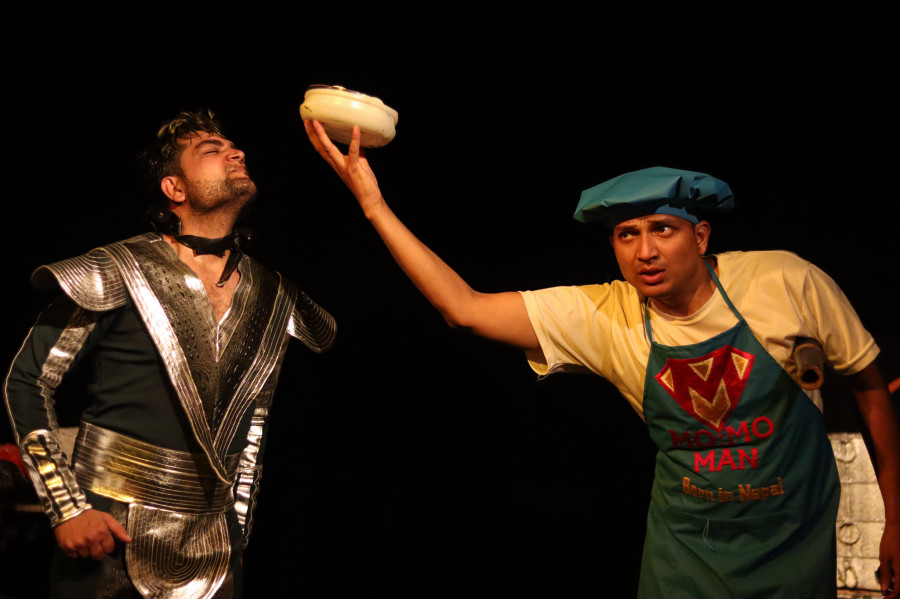Theater
‘It’s metaphor!’
Mandala Theatre’s ‘Ticket to Hollywood’ is entertaining, albeit not exceptional.
Anusha Dhakal
Pathetically endearing, Monty, the main character of ‘Ticket to Hollywood’ embodies a classical comedy protagonist. He is quirky, incompetent, persistent, and above all, likeable.
Monty (played by Sudip Khatiwada), enters the stage, and the whole theatre erupts into laughter. Renowned in the Nepali film industry and nicknamed ‘Metaphor Monty’, he is quite the opposite of a metaphor—shallow and easy to see through. Despite being immensely successful in his country, Monty strives to work in Hollywood, his true dream. The play follows Monty and his journey toward obtaining his ticket to Hollywood, showcasing the hindrances that stand in his way as he strives to realise his dream.
There are many obstacles for poor Monty: his chipped tooth, lack of a wisdom tooth, his deprived wife, a protest and his ambition, in some ways, is his biggest obstacle. If his ambition is the biggest obstacle, what is the real prize? The absurdity of the events happening to Monty perhaps represents, quite evidently, that it is leading up to something absurd—something that is the exact opposite of the outcome he envisions.
Or perhaps, Monty is a mirror to the audience, representing the human need to strive towards something, juxtaposed with the worldly truth that there is something absurd about it all, something that feels cartoonish, yet discernible.
This is why breaking the fourth wall feels like such a tasteful choice for the play. The actors communicate with the audience from the start, immediately transporting them into the world of the play. As the characters go about their circumstances, the audience interacts with the actors, enhancing the immersive experience, and inviting introspection.
However, as the play progresses, its charisma declines. Some scenes feel overly farcical, while others seem out of place, unnecessary, or even overdone. Monty develops a split personality through his newly planted wisdom tooth, which guides him through his circumstances in his quest to obtain his ticket to Hollywood. But as the play comes to an end, the audience is left without any explanation of the intentions behind the wisdom tooth, either as a plot device within the play or as a stylistic choice outside of it. I speculated that perhaps the lack of explanation is a metaphor, but honestly, to me, this absence feels more like a plot hole than a deliberate choice.
What saddens me is that this play, as a whole, holds incredible promise, and a few adjustments could have truly elevated it to exceptional heights. For instance, one of the most noticeable limitations is that the ‘moral lesson’ at the end of the play falls flat. There is a lot of buildup leading up to this moment, but despite its intention to be deep and evocative, it ultimately feels disappointing. Three sequences led to nowhere; these moments also felt boring and detracted from the earlier established charm of the play. At this point, much of the audience felt somewhat lost, whispering to each other about what certain elements might mean or how they fit into the narrative. I shared this experience, as I too began to feel lost, contemplating the potential significance of various elements.
A crucial scene in the play captures thematic elements resonant with our society, portraying a protest initiated for a seemingly trivial reason. This scene demonstrates the susceptibility of the youth to drama, mirroring aspects of contemporary societal dynamics.
This era of Nepali society is no stranger to silly antics for trivial reasons; after all, we are a generation shaped by ‘Nepal banda’. It is a little disappointing that such a crucial scene failed to effectively communicate its intended message. This scene was meant to tie everything together and highlight the sheer absurdity of Monty’s aspirations, potentially leading to a more satisfying conclusion.
However, it fell short, relying too heavily on physical comedy and leaving the audience with too little to grasp in terms of understanding the intended moral lesson.
It is not too difficult to infer that perhaps the intended moral lesson was about embracing our own identity and investing in our own industry. However, due to the excessive and unintelligent buildup, this grand lesson failed to resonate effectively with the audience.
Despite its narrative shortcomings, it’s important to acknowledge the exceptional musical elements that enriched the experience of ‘Ticket to Hollywood’. Anup Timilsina, the play’s music director, elevated the production by adding depth, vibrancy, and a sense of fun to the overall performance. The hook song ‘Ticket to Hollywood’ has been stuck in my mind for three days now; it is infectiously catchy. Having more musical elements would have made the play a more entertaining watch.
Besides the music, Milan Karki’s portrayal of Monty’s assistant is incredibly entertaining. His stage presence and charisma are truly undeniable. The outfits, particularly those of the two main characters and Monty’s wife, are also impressive. Had the actor portraying Monty’s wife in drag worn makeup, it would have elevated the overall look.
‘Ticket to Hollywood’ is hilarious, whimsical and amusing. It provides an antidote to Monty’s ambition by offering him closure that encourages embracing tradition. But do absurd ambitions require stringent antidotes? Or is ambition itself the antidote to the absurd abyss of human life? Guess you’ll need to watch the play to find out.
Ticket to Hollywood
Director: Sagar Khati Kami
Cast: Sudip Khatiwada, Milan Karki, Santosh Giri, Diggaj Khatri, Anup Timilsina
Language: Nepali
Duration: 1 hour 18 minutes
‘Ticket to Hollywood’ will be shown at Mandala Theatre in Thapagaun, New Baneshwar, Kathmandu, until May 5.
Show times: 4:00 pm everyday except Monday, Additional 7:30 pm show on Friday, Saturday and Sunday.




 18.35°C Kathmandu
18.35°C Kathmandu











